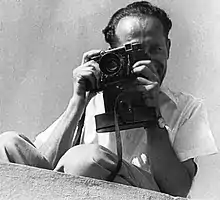Rudi Weissenstein
Shimon Rudolf "Rudi" Weissenstein (Hebrew: רודי ויסנשטין; February 17, 1910 in Jihlava, Bohemia – October 20, 1999 in Tel Aviv) was an Israeli photographer. He was best known for his extensive photo documentation of the everyday life of Jewish immigrants in the 1930s. The only photographs of Israel's declaration of independence by David Ben Gurion in 1948 are by Weissenstein, who built a collection of over a million negatives.[1]
Rudi Weissenstein | |
|---|---|
 Rudi Weissenstein in 1940 | |
| Born | Shimon Rudolf Weissenstein 17 February 1910 |
| Died | 20 October 1999 (aged 89) |
| Nationality | Austria-Hungary, Czechoslovakia, Mandate Palestine, Israel |
| Known for | photography |
Biography
Rudi Weissenstein was born in 1910 in the Bohemian-Moravian town of Jihlava and grew up as one of four children. From 1929 to 1931 he completed an apprenticeship as a book printer at the Graphische Lehr- und Versuchsanstalt in Vienna. He then completed his military service in the Czechoslovak army and then worked as a photographer at the Prague and Vienna newspapers. Since 1934 Weissenstein planned his emigration to Palestine and he left Europe in the late 1935, reaching Haifa in January 1936. He continued to work as a photographer and journalist and in 1940 married Miriam Arnstein (1913-2011), who had studied dance and acrobatics in Vienna and had emigrated to Palestine before Weissenstein. Together they opened Photo House Pri-Or in Tel Aviv on Allenby street in 1940. Weissenstein documented the Jewish everyday and cultural life in Tel Aviv, including numerous prominent personalities - artists and politicians, such as Marc Chagall, Max Brod, Eleanor Roosevelt, Isaac Stern and the painter Nahum Gutman. He photographed for the Israel Philharmonic Orchestra since the first concert conducted by Arturo Toscanini. Weissenstein's most well-known photograph is that of the Declaration of Independence of the State of Israel on May 14, 1948, by David Ben Gurion, where he was the only accredited photographer.[2]
Legacy
Rudi Weissenstein died in 1992 and his estate - a photo archive of more than 250,000 negatives was managed and maintained by his widow until her death in 2011. Since 2011, the archive and Photo House is managed by his grandson Ben Peter Weissenstein in a new store on Tshernichovski Street, received from the Tel Aviv municipality. Miriam Weissenstein and Ben Peter Weissenstein were part of the documentary film "Life In Stills" by Tamar Tal, dealing among other things with the history of the photo house, which Rudi Weissenstein had opened.[3]
Exhibitions
Weissenstein's photographs have been shown and awarded numerous prizes in Israel and abroad, among others in 1961 with the award at the International Photography Exhibition in Moscow for the recording "Working Hands". His works were exhibited in Heussenstamm Gallery in Frankfurt, Germany; Eckhart Gallery, The Hague; The Jewish Museum in Munich, Germany.[4] The last exhibition in Germany "Your happy eyes" in 2010 was opened by Miriam Weissenstein.
Bibliography
See also
- Ze'ev Aleksandrowicz (1905-1992), Polish-born photographer, active in Mandate Palestine between 1932-1935
- Zoltan Kluger (1896-1977), important photographer in pre-state Israel
- David Rubinger (1924-2017), Israeli photographer, author of photo of paratroopers at the Western Wall in Six-Day War
- Samuel Joseph Schweig (1905–1985), landscape and archaeology photographer in Mandate Palestine and early Israel
- de:Herbert Sonnenfeld (1906-1972), German Jewish photographer, husband of Leni, photographed in Mandate Palestine in the 1930s[5]
- Leni Sonnenfeld (1907-2004), German Jewish photographer, wife of Herbert, photographed Israel in the early years of its existence[5]
References
- "Rudi Weissenstein". Retrieved 2018-09-22.
- Avidan, Igal. "Pictures of a city". Der Tagesspiegel. Retrieved 2018-09-22.
- Tchechik, Daniel (2017-11-20). "The Year Is 1936. A Man Picks Up a Camera, Captures an Israel That's No More". Haaretz.com. Retrieved 2018-09-25.
- "Rudi Weissenstein". Retrieved 2018-09-24.
- Beit Hatfutsot Photo Collections, The Herbert and Leni Sonnenfeld Collection, accessed April 2020